Ahmed Salah - Egyptian Revolution Organizer

Organizer of the Tahrir Square Demonstrations that ousted Egyptian President, Hosni Mubarak
During the early weeks of November 2011, the Technology & Society department of Polytechnic Institute of New York University began a lecture series of which the first was titled "Wikileaks, Egypt's Revolution, and Occupy Wall Street". The first lecture featured Ahmed Salah from Cairo, Egypt and Chris Hables Gray. Mr. Gray began the lecture by talking about his understanding of what the term 'revolution' meant to him. His experience in protesting and organizing such events, he went onto say, did not differ much in how protests and other forms of non-violent actions were done today. Yet he noted, how those were done have changed alot especially with the introduction of social media. He then proceeded to introduce Ahmed Salah, an academic colleague from Egypt who was at the forefront of the revolutionary change in Egypt. Ahmed Salah used Skype to connect from Egypt and sitting in a chair in a closed room, proceeded to tell us the relevance of Social media in Egyptian revolution. It was around 1am, but Mr. Salah seemed eager to tell his audience about his experiences that defined his understanding of how a revolution should be done. His accounts of setbacks and troubles rested on three main cases. First no one wanted to take a day off work to join in on any protests or other revolutionary acts. It would mean a day without income for their families. Second case Ahmed argued is that people were fearful. Nobody wanted to be tortured, jailed or beat. Finally the people of Egypt was simply hopeless. It was a lost cause in their eyes. How many times would they have to protest?
One might ask, "why now, why did the revolution happen the way it did?" Mr. Salah pointed to five points to which he believes were the cause. The government took the unusual step of stopping the usual parliamentary elections. It was speculated that President Hosni Mubarak took this action to give time for his son to assume full power. High-ranking members of Egyptian military defected, it started with an intelligence service member! This gave the scattered voices of activists concrete evidence for a revolution. The people of Egypt were at crossroads of decisions, Ahmed Salah became their catalyst for the revolution.
Social media was used as a tool to organize people, though it wasn't the primary form of advocacy. Social media was public and whether it was a Facebook group or large-group email, someone in the government would eventually read it. In its use, social media was a tool to generally inspire and inform but the crux of the movement rested upon person-to-person communication. Ahmed went about stimulating causes that were dear to the people to bring about a sense of identity to the movement. Ahmed explained these causes as two-part. He started a chain of "good lies".

Urban Design
First he started telling mothers at social spaces to tell other mothers to stock up food and encouraged them to speak up if they noticed anything out of the ordinary. He then told them convincingly how he believed something was going to happen on a certain date. Ahmed utilized public markets and shopping bazaars, which in Urban Design is critical in functioning as a gathering space and social scene. Mothers are more often trusted by family members as reliable sources thus they were instrumental in spreading the date of the revolutionary protests. Mothers went about convincing everyone and raising the level of alertness in their respective communities. This led to people stepping out of their fears because they had to face the unexpected. Ahmed then reached out towards the youth. Egyptian youth were caught up in soccer, known to the public as the hooligans, most youth were active members of either of the two major soccer teams' fan groups. Ahmed went to one group and told them the other team's fan group was coming out to celebrate on a particular date and if their group wasn't coming out to root for their team it'd show they weren't truly fans or loyal to their team. This was also said to the other group thus getting more age groups involved in the process of change. In all these instances, Ahmed made sure the date was the same so if he started a protest it'd be a little easier to gather some people. In doing these activities Mr. Salah was doing a bottom-up approach, though indirectly, in involving multiple groups that are an asset to a community. Their involvement dragged many others into the protests with the hope that this time it was going to be different.
Like social media, the value of Urban Design became a key to unlocking the full potential of the protests. The location of the protests were planned systematically. Ahmed planned knowing fully that many would be hesitant to join in initially. So having secured a group of dedicated revolutionaries, he went to a small town with the group. Once there his group secured a street corner, such that rows of police officers would be forced to break formations to arrest anyone on their terms. It also was to give the sense of a larger crowd as a result of the scale of the people to the streetscape and background objects. We learn from serial vision that townscapes tend to have more varied styles and architecture. As a result this presents environments in a series of jerks. The image of a small area with a handful of people amplified their presence. The interwoven streetscape and markets prevented the carefully orchestrated police formations from advancing in on their positions. This technique helped start the revolution, once others saw how successful it was, the protests became a revolution.
Cite this page
MLA Format
Soman, Stanley. "Ahmed Salah - Egyptian Activist - The Co-founder of the April 6th Movement." ExpertsColumn on HubPages. HubPages, 23 Dec. 2012. Web. 27 Dec. 2012(Replace with the date of your access). <http://expertscolumn.hubpages.com/hub/Ahmed-Salah-Cofounder-of-the-April-6th-Movement>.
APA Format
Soman, S. (2012, December 23). Ahmed Salah - Egyptian Activist - The Co-founder of the April 6th Movement. ExpertsColumn on HubPages. Retrieved December 27, 2012(Replace with the date of your access), from http://expertscolumn.hubpages.com/hub/Ahmed-Salah-Cofounder-of-the-April-6th-Movement
Press Release from NYU-Poly on Mr. Ahmed Salah
- Keyboard Activists Called Out At Technology & Society Lecture Series Kickoff | NYU-Poly
"Get up from your keyboard," urged Ahmed Salah, one of the chief supporters of the overthrow of longtime Egyptian president Hosni Mubarak, as he answered a first-year student asking for recommendations on getting others more politically involved....








